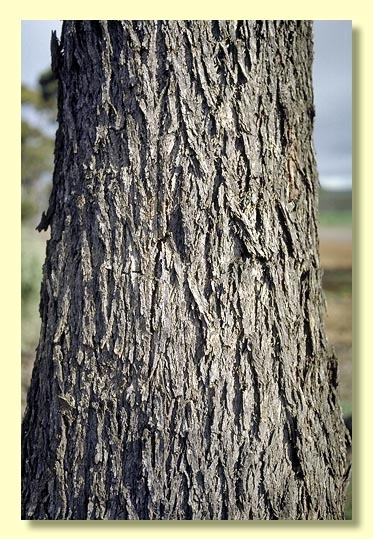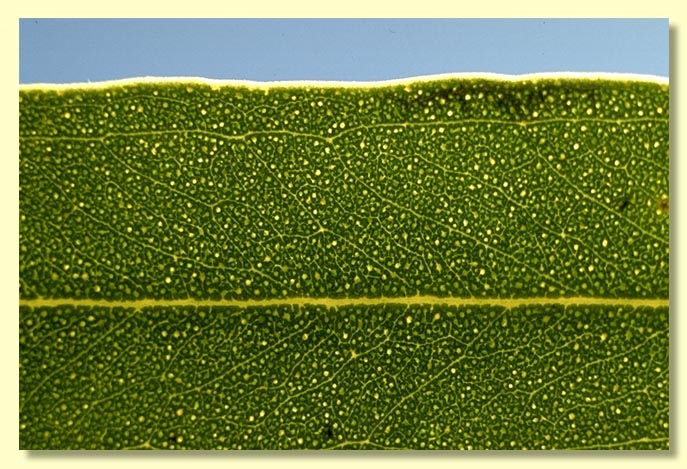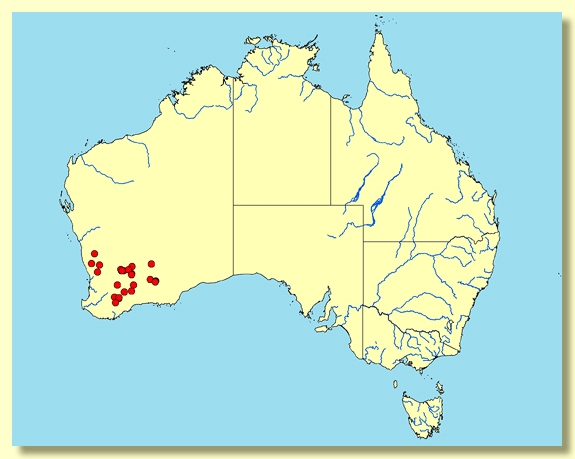Euclid - Online edition
Eucalyptus longicornis
Eucalyptus | Symphyomyrtus | Bisectae | Destitutae | Subulatae | Spirales
Usually a well formed tree to 25 m tall, rarely a mallee. Forming a lignotuber.
Bark usually rough over most of the stem, occasionally rough on the lower stem only, hard fibrous, fissured grey to grey-brown, larger branches usually smooth-barked, white to grey, rarely pink-grey to green-grey.
Branchlets lacking oil glands in the pith.
Juvenile growth (coppice or field seedlings to 50 cm): stems square to five-sided, glaucous; juvenile leaves sessile, spirally arranged, 2–8.5 cm long, 0.9–2.6 cm wide, elliptical to ovate to lanceolate, glaucous.
Adult leaves alternate, petioles (0.8) 1–1.5 (1.9) cm; blade linear to narrowly lanceolate, occasionally falcate, 6–13 cm long, 0.6–1.3 (1.5) cm wide, base tapering to the petiole, margin entire, glossy green, side-veins acute, usually less than 45° to the midrib, rarely greater, reticulation moderate to dense, sometimes obscured by numerous intersectional oil glands, intramarginal vein present but can also be obscured by the oil glands.
Inflorescence axillary unbranched, peduncles erect, 0.6–1.3 cm long, buds usually more than 7 per umbel, pedicellate, pedicels 0.4–0.9 cm long. Mature buds ovoid (0.9–1.5 cm long, 0.3–0.6 cm wide), scar present, operculum long and slender (horn-shaped) ((0.4)0.7–1 cm long), stamens irregularly flexed, anthers globoid, basifixed, adnate, dehiscing by lateral pores, style long and straight, stigma blunt to tapering, locules 3 or 4, the placentae each with 4 vertical rows of ovules. Flowers white.
Fruit pedicellate, pedicels 0.3–0.5 cm long, truncate-globose to rarely truncate-ovoid, 0.4–0.6 cm long, 0.4–0.7 cm wide, disc descending, valves 3 or 4, valve tips strongly exserted due to fragile style remnants.
Seeds brown to grey, 1.2–2 mm long, flattened-ovoid, dorsal surface smooth, occasionally with longitudinal furrows, hilum ventral.
Cultivated seedlings (measured at node 10): cotyledons Y-shaped (bisected); stems square to five-sided in cross-section; leaves opposite, sessile and linear for the first few nodes then spirally arranged, sessile and linear to narrowly elliptical, 0.6–1.7 cm long, 0.1–0.7 cm wide, dull, grey-green to green.
Flowering has been recorded in February.
A large rough-barked tree of the wheatbelt and goldfields, from Wongan Hills south to Broomehill and east to the Southern Cross – Manning Range area where it is sometimes of smaller stature. The adult leaves are narrow and glossy green, the buds are narrowly ovoid, with a long acute operculum.
Eucalyptus longicornis belongs in Eucalyptus subgenus Symphyomyrtus section Bisectae subsection Destitutae because buds have two opercula, cotyledons are Y-shaped and branchlets lack oil glands in the pith. Within this subsection E. longicornis is part of the large taxonomic group series Subulatae further characterised by globoid basifixed anthers, grey smooth seeds with shallow longitudinal furrows, and fruit with persistent exserted style remnants. Series Subulatae is divided principally into four subseries based on the juvenile leaves: one with spiral, crowded seedling phyllotaxis (subseries Spirales), another with decussate and decurrent seedling leaves (subseries Decurrentes), another with decussate non-decurrent seedling leaves (subseries Decussatae), and a fourth with disjunct, petiolate seedling leaves (subseries Oleaginae).
E. longicornis belongs to subseries Spirales characterised by the heath-like seedlings with crowded linear leaves. The other members of this group are E. delicata and E. oleosa. E. longicornis is the only member of this group that consistently grows to form a large tree. E. delicata is normally a small tree or mallee and E. oleosa is normally a mallee, sometimes developing into a small tree. E. delicata differs further by having smaller buds and fruit than E. longicornis (E. delicata with buds 0.5–0.8 cm long, ca 0.3 cm wide, with an operculum no longer than 0.5 cm; E. longicornis with buds 0.9–1.5 cm long, 0.3–0.6 cm wide and an operculum normally longer than 0.7 cm). E. oleosa differs further by having buds with a shorter, usually blunter opercula.
The buds of E. longicornis are like those of the related mallee, E. longissima, but this species belongs in subseries Oleaginae, having petiolate, lanceolate seedling leaves. Within the eastern part of the distribution for E. longicornis , where it can sometimes be of smaller stature, it may be confused with the unrelated E. horistes. Both have narrow, glossy adult leaves and narrow ovoid buds with a long acute operculum. Both are easily separated by their juvenile leaves. E. longicornis has very narrow heath-like juvenile leaves while E. horistes has glaucous, orbicular to cordate to elliptical juvenile leaves. In the absence of juveniles, E. horistes is easily separated by having strongly inflexed stamens, where the inner row of stamens is often shorter than the rest and the anthers not fully developed. The stamens in E. longicornis are irregularly inflexed.














